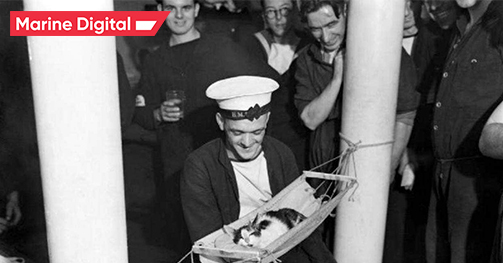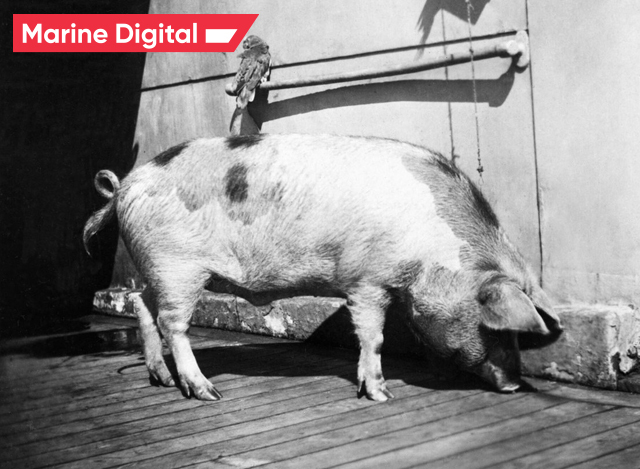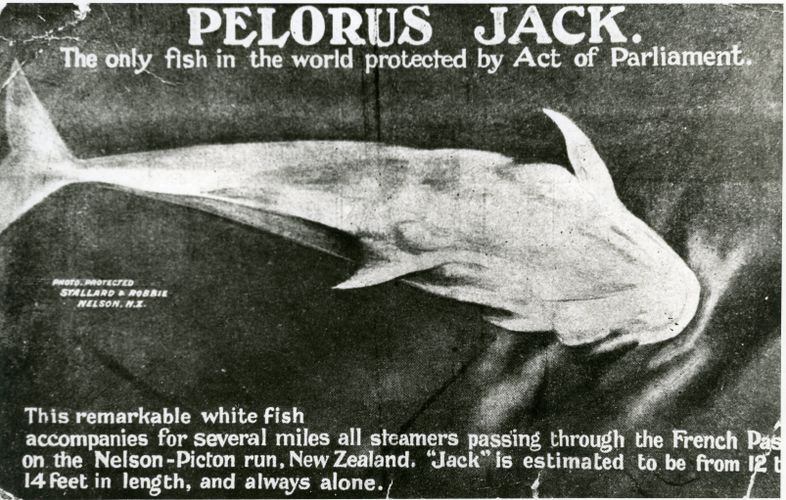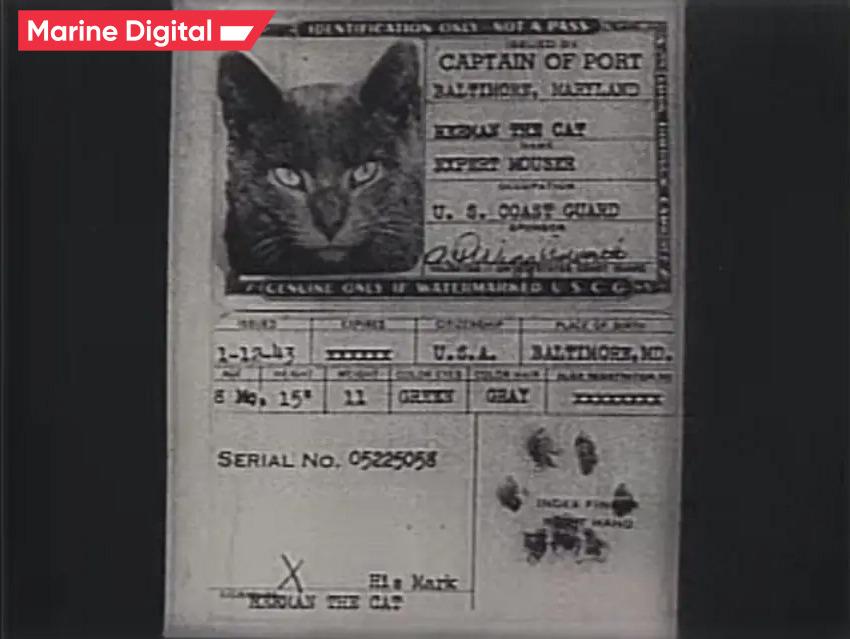For the entire history of mankind, animals accompany us: they help us in agriculture and war, provide food, clothing, protect property, catch rodents and etc. You can find many stories about the heroic deeds of different species in various spheres of human life. But what record did they put in maritime navigation? Here are some famous stories of amazing animals on vessels and in shipping.
Unsinkable Sam

The credibility of the story of Unsinkable Sam (aka Oscar) raises a lot of doubts and controversy - it is too incredible, but at the same time, it is one of the most famous and often retold stories, so it deserves to be mentioned here.
Oscar, as the British sailors called him, was
a German black and white cat who "served" on board the battleship Bismark until the sinking of the ship in 1941. Keeping cats on board is an old tradition that is still practiced today: cats fight rodents, which pose a threat to food supplies and various electronic components. Ship cats have always been favorites of sailors, not only hunters but also simply “pets”.
When Bismark sank, the sailors of the British destroyer Cossack found a stubborn cat clinging to the wreckage of the destroyed battleship, and happily took him aboard their ship.
Later that year, Cossack himself sank after a submarine attack, and again Oscar held out long enough to be rescued by sailors from a nearby ship. Following this incident, the cat was taken to port and joined the crew of the Royal aircraft carrier Ark Royal to return to his rat hunting duties. This was the last warship on which he served, and this service was short-lived, as in November 1941 the Ark Royal was destroyed in a torpedo attack. Fortunately, Oscar still had seven lives left: he was again found floating in the wreckage and rescued. For the long list of sunk ships that Oscar survived, he was renamed Unsinkable Sam.
Simon the cat that received the Mary Deakin Medal

A cat named "Simon" from the Royal Navy's Amethyst sloop awarded Britain's highest military award for animals - the Mary Deakin Medal.
In March 1948, 17-year-old junior sailor George Hickinbottom, a member of the crew of the British patrol ship HMS Amethyst, found Simon at the Hong Kong shipyards and secretly took him aboard the ship. Thanks to his good ability to catch and kill rats that swarmed the lower decks, Simon quickly gained the trust of the crew. The crew considered Simon to be the ship's mascot.
At the end of the 1948 year, Ian Griffiths, the former captain of the ship, handed the cat over to his successor, Bernard Skinner, who also liked the friendly cat. Skinner's first assignment aboard the Amethyst was to sail up the Yangtze River to Nanjing to replace the HMS Consort. Halfway up the river, Chinese communist batteries opened fire on a patrol ship (historians would later call the incident "the Yangtze River incident"). One of the first volleys went through the captain's quarters, killing Skinner and seriously injuring Simon.
Badly wounded cat crawled out on deck. The sailors saw him and rushed to the ship's infirmary. In the infirmary, the doctors who survived the shelling gave him first aid. Simon was covered with burns and shrapnel wounds. The burns were treated and four shrapnel bullets were removed from the body. Few thought that he could last at least until the morning. However, the cat survived and even returned to his duties. At the sight of the cat, even very young sailors understood that injury was not a reason to lose heart.
Fame came to Simon immediately after the ship returned from the river. He was featured in the news not only in Britain but around the world. He was awarded the Maria Deakin Medal ("Victoria Cross for Animals"), the Blue Cross Medal, the Amethyst Medal for the campaign, and even received the unusual title "Cat - Excellent in Marine Service".
Generous Judy

If a cat on a ship can be useful in two roles - to exterminate rodents and simply to please with its presence, some crews take animals on board with the sole intention of keeping them as talismans in order to increase the morale of sailors. The marine mascot can be anything from cats and dogs to monkeys and goats. One of these pets was an English Pointer dog named Judy. She served aboard the gunboat HMS Grasshopper when it was attacked and sunk by Japanese torpedo bombers in 1941. The crew was captured, but the sailors were allowed to take Judy with them to the POW camp, where they were to spend the rest of the war. The prisoners managed to convince their jailers to register the dog as a prisoner of war so that it would stay with them. It is known that Judy defended her comrades with all her might, barked angrily at the camp guards and, according to some reports, brought food to malnourished prisoners. For her courage and ability to keep the morale of prisoners in 1945, Judy was also awarded the Maria Deakin Medal.
Tirpitz the Pig

This story took place during the First World War. German light cruiser Dresden collided with Royal Navy cruisers Kent and Glasgow off the coast of Chile. The defeated Germans sank the cruiser, and most of the crew were captured. However, one survivor was thrown aboard by fleeing German sailors. Glasgow's crew was surprised to see a frightened pig fighting for life aboard a sinking ship, and a sailor decided to rescue her. Initially, the piglet was intended to go under the cook knife and become dinner for the crew of a German cruiser. But the crew of the British ship decided to make it their mascot. The new pet was named Tirpitz - in honor of the German admiral. The sailors even awarded Tirpitz with a fake Iron Cross for being the only one who did not leave his ship. The pig served in the Royal Navy for a year before being taken to the artillery school on Wal Island near Portsmouth. Unfortunately for Tirpitz in 1919, he was overtaken by his original fate: he was sold at an auction for meat. The head of the tirpitz is still kept in the Imperial War Museum in London.
Pelorus Jack, a Risso’s dolphin

Pelorus Jack, a Risso’s dolphin (uncommon in New Zealand) that accompanied ships traveling from Pelorus Sound to treacherous French Pass. His habit of escorting ships had established him as a major tourist attraction, attracting visitors from all over the world.
In early 1904, a passenger aboard the SS Penguin pulled out a gun and tried to shoot Pelorus Jack. Luckily a fleet of screaming passengers alerted the crew about the danger and they were able to restrain and disarm him. Pelorus Jack was protected by Order in Council under the Sea Fisheries Act - possibly the only individual sea creature to be legally protected. Despite the attempt on his life, Pelorus Jack continued to help ships, but he never accompanied the Penguin again, seamen's superstitions about the ship being abandoned by the piloting dolphin later confirmed were the Penguin later sunk off the South Wellington Coast with the loss of 75 lives.
Duck bath toys

In 1992 a shipping crate bound for the US from Hong Kong fell overboard and was lost at sea. The cargo that spilled into the ocean was 28,000 plastic duck bath toys.
Those toys have been following ocean currents ever since reaching every continent but Antarctica, including surviving the Arctic Ocean and moving around North America to reach the British Isles.
Scientists have been using the data collected from ships spotting the yellow tide or duckies washing ashore to study ocean patterns and how long it takes for them to navigate the globe.
Herman The Cat Expert Mouser

in 1943, Cat Herman was officially hired by the United States Coast Guard as an "Expert Mouser" to control or eradicate the rodent population aboard ships. The green-eyed gray cat entered service at eight months old, and his ID card was issued in his hometown of Baltimore on January 12 with no expiration date. In other words, he was just as much a member of the military as everyone else, especially since his ID even bore the formal serial number 05225058 and was verified by the appropriate official.
Thus, the Maryland pet was given the unlimited right to be at any time on the waterfront of the port, where he could hunt mice and rats to his full satisfaction - after all, it was his job.
It was the norm for every ship in the Royal Navy until 1975 to have a cat on board. They, like all other pets, were banned this year due to hygiene concerns, but cats like Simon and Unsinkable Sam have made important contributions since cats were really important on ships around the 1900s. because their natural instinct has always been to attack and kill rodents. Thus, they not only prevented the spread of dangerous diseases from one place to another but also ensured the safety of stored products or items and largely controlled the overall damage to infrastructure.












